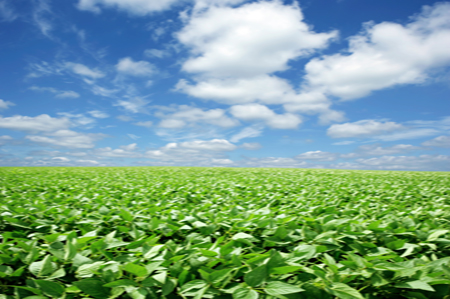 (Agriculture.com) – As the soybean prices in Chicago may be worrying a lot of farmers in several places, Brazil might increase its surface dedicated to the oilseed during the 2015/2016 crop season. According to Carlos Cogo, an experienced consultant based in Porto Alegre, Rio Grande do Sul, the total soybean area in the country will jump to 81.2 million acres or a production of 100 million metric tons – up from 78.8 million acres in 2014/2015.
(Agriculture.com) – As the soybean prices in Chicago may be worrying a lot of farmers in several places, Brazil might increase its surface dedicated to the oilseed during the 2015/2016 crop season. According to Carlos Cogo, an experienced consultant based in Porto Alegre, Rio Grande do Sul, the total soybean area in the country will jump to 81.2 million acres or a production of 100 million metric tons – up from 78.8 million acres in 2014/2015.
It is not that Brazilian farmers are very happy about the current prices, but that they want to exploit the never-ending agricultural frontiers available for farming; they also feel more confident about soybeans than growing corn historically, most observers say. Projections of the Mato Grosso Institute of Agricultural Economics and the Association of Soybean Growers of Mato Grosso (Aprosoja) estimate that the surface in Brazil’s top producing state will not grow more than 4%.
Luiz Nery Ribas, technical director of Aprosoja, explains that the growth is the continuation of what has been happening in the last years: the recovery of degraded pasture in areas like the east and northwest of Mato Grosso. However, he says that this year farmers are anything but optimistic.
“The climate is of apprehension among farmers here. There is a worry about the weather, prices, increasing costs, shortage of credit, and the uncertainty about the dollar,” Ribas tells Agriculture.com, also revealing that Mato Grosso lately has seen dry days with sporadic rains on the eve of planting, which starts by September 15.
A good way to gauge the mood of farmers and their capitalization is at Expointer, a top farm show held in Esteio, within the greater Porto Alegre, Rio Grande do Sul. The machinery sales in this ag fair dropped 37% compared to last year.
Dealerships and farmers blame the fall on delayed credit releases and higher interest rates.
“As banks have been more careful to release credit at subsidized rates, some farmers end up giving up on some purchases. More people are paying with cash. Farmers are spending less on machinery because they invested too much up until 2014; now we are going back to normality. But by observing other years, I would say that in the region I cover [Rio Grande do Sul, Santa Catarina, and Paraná], the soybean acreage will increase in Rio Grande do Sul because of new agricultural frontiers,” affirms Ediney Amaral, New Holland’s regional manager of sales in southern Brazil. For Rio Grande do Sul, the third-largest soybean state, estimates say that the area planted with the oilseed will jump nearly 3% in the southern part of the state, where rice is traditionally grown along with cattle.
Vítor Dalmina, who is a soybean farmer from Northeastern Rio Grande do Sul, invested in a forage machine to rent to neighboring producers. This year he will plant 1,976 acres of soy, the same amount he does every year.
“The new machine will be used to add more wealth. But if the current [soybean] prices are maintained, that will be fine I guess,” Dalmina tells Agriculture.com.
Augusto Machado Gonçalves from São Gabriel, a new frontier in southwestern Rio Grande do Sul, purchased a sprayer that cost nearly US$ 126,000 with annual rates of 7.5%. He intends to plant in 2015 about 2,000 acres of soybeans.
“I had three consecutive record crops and the prices are still good. I got to keep investing to maintain the profitability,” Machado declared to local newspaper Zero Hora.
After having the slowest July in soybean sales, Brazil accounted more exports until August than the whole year of 2014. The Ministry of Development, Industry and Foreign Trade revealed that the country exported 5.16 million tons of the grain in August. The accumulated volume exported over the year is 45.85 million metric tons. Even so, farmer revenues reduced 24.2% because of the price of the oilseed – falling from US$ 510.19 per ton to US$ 386.72/ton.
Market analyst Carlos Cogo says farmers were retaining grain in order to wait for more devaluation of Brazil’s Real against the U.S. dollar, but as planting approached and soybeans improved in Chicago in August, sales jumped. The new crop is nearly 35% sold.
“As financial needs increased, credit was expensive and stocks were high, the only option was to sell soybeans,” analyzes Cogo in an interview with Agriculture.com.
Farmers from the state of Roraima are interestingly in an opposite routine. As the state is located in Northern Brazil and above the Ecuador line, the soybean season follows the calendar of the Northern hemisphere like in the United States. Roraima planted 61,776 acres of non-GMO soybeans this year.
Producer Aluizio Nascimento has just started harvest and is happy about the yields and the results. “As of now, we are getting US$ 18 per bag (US$ 8.16 per bushel), and the yields 44.54 bushels per acre,” says Nascimento.




